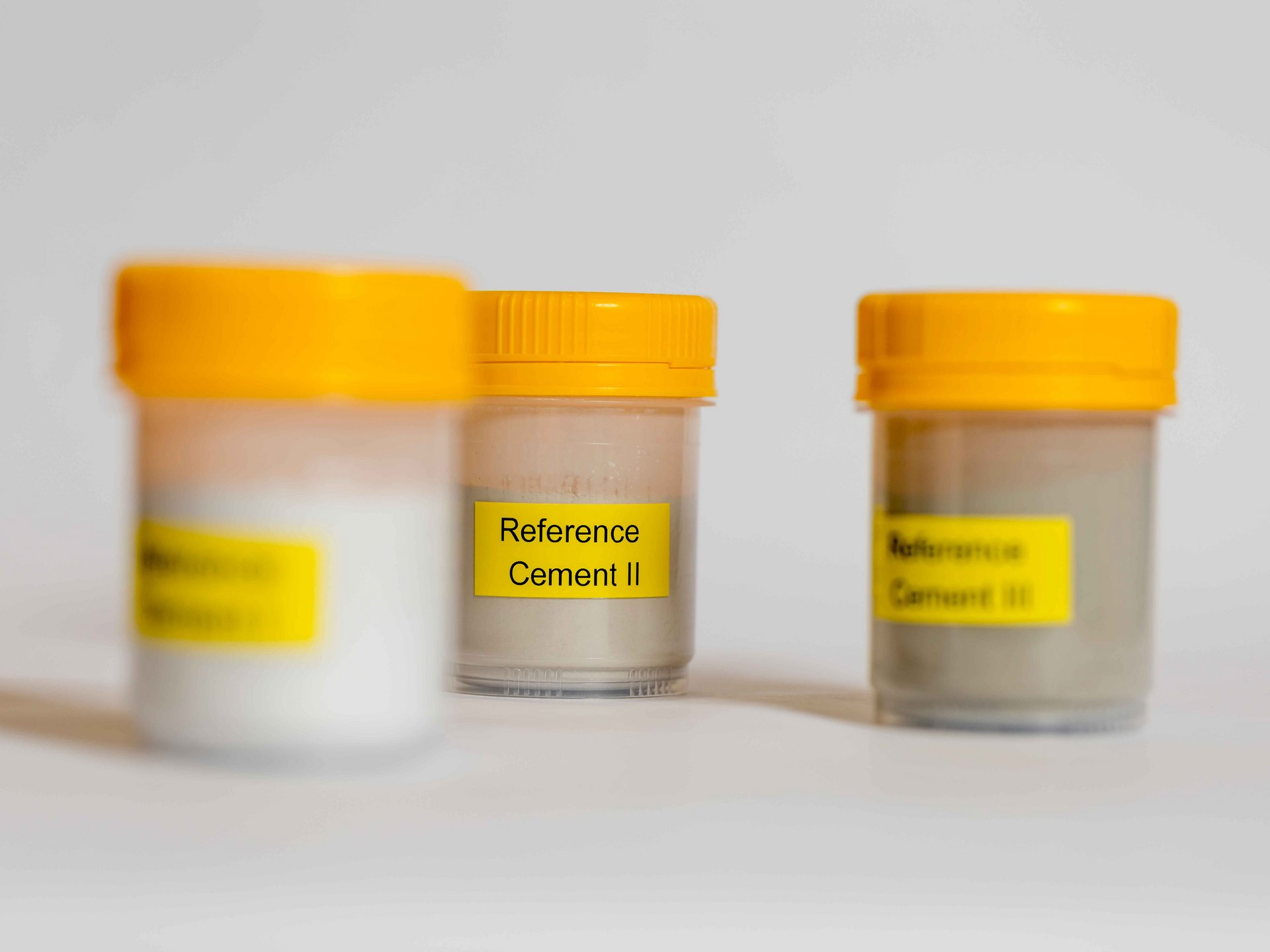We can offer the following reference materials:
a) Reference cements VDZ100a, VDZ200a and VDZ300a
The reference cements VDZ100a (CEM I), VDZ200a (CEM II/B-M (S-LL) and VDZ300a (CEM III/B) were characterised in a round robin test. Each of these cements can be obtained in units of approx. 200 g. This quantity is divided into four containers, each containing approx. 50 g of material. They are supplied together with the mean values of the round robin test, the reproducibility standard deviations as well as the uncertainties derived from these. The materials can be used in the laboratory for calibration or quality control purposes for example. Reference values are available for the following methods:
- X-ray fluorescence analysis in accordance with DIN EN 196-2
- Wet chemical analyses in accordance with DIN EN 196-2 (alkalis, sulphide, sulphate, chloride)
- Free lime content
- Mineral phases based on X-ray diffraction and Rietveld refinement
- Cement composition in accordance with CEN/TR 196-4
- Trace elements
- Particle size distribution
- Surface area (Blaine)
- Density
- Heat of hydration (7d) in accordance with DIN EN 196-11
Some data sheets containing detailed information can be found here.
b) Reference and test cements for the determination of water-soluble chromate
Reference cement VDZ400
The reference cement VDZ400 was characterised in a round robin test. This is a Portland cement CEM I 42,5 R with no addition of chromate reducing agent. The packaging of such a cement is particularly important for the assurance of the stability of the reference value. For this reason, the material is sealed air-tight in separate units of 500 g in vacuum bags so that each unit provides sufficient material for testing on standard mortar in accordance with DIN EN 196-10.
- Approx. 0,3 ppm water-soluble chromate in accordance with DIN EN 196-10
- Packing unit: 10 x 500 g (separate air-tight sealed units)
Reference cement VDZ410
The reference cement VDZ410 was characterised in a round robin test. This is a Portland cement CEM I 52,5 N with no addition of chromate reducing agent. The packaging of such a cement is particularly important for the assurance of the stability of the reference value. For this reason, the material is sealed air-tight in separate units of 500 g in vacuum bags so that each unit provides sufficient material for testing on standard mortar in accordance with DIN EN 196-10.
- Approx. 6 ppm water-soluble chromate in accordance with DIN EN 196-10
- Packing unit: 10 x 500 g (separate air-tight sealed units)
Test cement "Chromate" VDZ430 (e.g. for approval of chromate reducers)
The test cement VDZ430 ("Chromate") is a Portland cement CEM I 52,5 N with no addition of chromate reducing agent. The water-soluble chromate content is well above 10 ppm to also permit the use of this cement for approval of chromate reducers.
- Packing unit: 1 x 5 kg (sealed air-tight in vacuum bag)
c) Reference material for determination of chlorine and calorific value
The reference material for determination of chlorine and calorific value was characterised in a joint round robin test together with the Gütegemeinschaft Sekundärbrennstoffe und Recyclingholz e.V. (BGS) by 43 test laboratories. The material is a polymer granulate, to which a defined quantity of chlorine was homogeneously added through the specific addition of PVC.
- Chlorine content approx. 8,200 mg/kg in accordance with DIN EN 14582, DIN EN 15408
- Gross calorific value: approx. 39,200 kJ/kg (in accordance with DIN 51900, DIN EN 15400)
- Packing unit: approx. 180 g
d) ASR test cement in accordance with Alkali Guidelines
In accordance with the Alkali Guidelines of the German Committee for Structural Concrete (DAfStb), testing bodies have to make use of a standard ASR test cement for determining the alkali reactivity of aggregates. We can provide you with this cement with a high alkali content along with essential information on its properties. This reduces the variation between different testing bodies.
e) Reference aggregate for use in the accelerated mortar bar test
For the determination of the alkali reactivity of aggregates, many testing laboratories perform the accelerated mortar bar test (AMBT) according to RILEM AAR-2.2. In Germany, the method is described in the Alkali Guidelines of the German Committee for Structural Concrete (DAfStb) and in TP B-StB. The specifically formulated sand exhibits a high degree of homogeneity and can be used as a monitoring sample for these procedures. The sand is packed in portion bags of 1250 g, which can be used directly for the production of mortar. In the VDZ laboratory the average expansion of mortar bars with the material is 0.144 % (1.44 mm/m) after 13 days and 0.158 % (1.58 mm/m) after 14 days.

